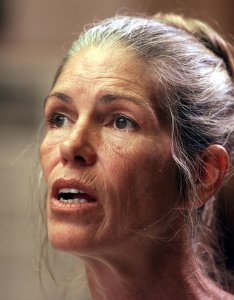California Gov. Gavin Newsom overruled a parole board’s decision to free Charles Manson follower Leslie Van Houten on Monday, marking the third time a governor has stopped the release of the youngest member of Manson’s murderous cult.
Van Houten, 69, is still a threat, Newsom said, though she has spent nearly half a century behind bars and received reports of good behavior and testimonials about her rehabilitation.
“While I commend Ms. Van Houten for her efforts at rehabilitation and acknowledge her youth at the time of the crimes, I am concerned about her role in these killings and her potential for future violence,” he wrote in his decision. “Ms. Van Houten was an eager participant in the killing of the LaBiancas and played a significant role.”

No one who took part in the Tate-LaBianca murders has been released from prison. It was the first time Newsom rejected parole for Van Houten, while former Gov. Jerry Brown denied her release twice.
“Nobody wants to put their name on her release, but when they’re speaking honestly or off the record, everyone wants her to go home,” said Van Houten’s attorney, Rich Pfeiffer.
Newsom is “going to have more political aspirations that go well beyond the state of California, and he doesn’t want this tagging behind him,” he added. “Not a surprise. I would have been shocked if he would have said ‘Go home.'”
Earlier this year, Newsom reversed a parole recommendation to free Manson follower Robert Beausoleil for an unrelated murder. Beausoleil was convicted of killing musician Gary Hinman.
Newsom’s decision on Van Houten outlined her participation in graphic detail, noting that after the killings, she “drank chocolate milk from the LaBiancas’ refrigerator” before fleeing.
“The gruesome crimes perpetuated by Ms. Van Houten and other Manson Family members in an attempt to incite social chaos continue to inspire fear to this day,” Newsom wrote.
Van Houten is still minimizing her responsibility and Manson’s “violent and controlling actions,” he said, and she continues to lack insight into her reasons for participating.
Van Houten’s lawyer said in January after her latest release recommendation that the parole board found she had taken full responsibility for her role in the killings.
“She chose to go with Manson,” Pfeiffer said. “She chose to listen to him. And she acknowledges that.”
Van Houten has described a troubled childhood that led her to use drugs and hang around with outcasts. When she was 17, she and a boyfriend ran away to San Francisco during the so-called Summer of Love in 1967.
She later encountered Manson while traveling the coast. Manson had holed up with his “family” at an abandoned movie ranch on the outskirts of Los Angeles when he launched a plan to spark a race war by committing a series of random, terrifying murders.
Brown rejected parole for Van Houten in 2017 because he said she still blamed the cult leader too much for the murders. A Los Angeles Superior Court judge upheld Brown’s decision last year, finding that Van Houten posed “an unreasonable risk of danger to society.”
An appeals court will decide whether to uphold or reject that ruling by the end of July.
“No governor’s ever going to let her out,” said Pfeiffer, Van Houten’s attorney who’s pinning his hopes on the appeals court. “They are bound by law to enforce the law independently. They have to do it whether or not it’s popular with the public … and the law is that she should be released.”
Manson and his followers were sentenced to death in 1971, though those punishments were commuted to life in prison after the California Supreme Court ruled capital punishment unconstitutional in 1972. Van Houten’s case was overturned on appeal and she was later convicted and sentenced to seven years to life in prison.
Tate’s sister, Debra Tate, has routinely shown up to parole and court hearings to oppose the release of any Manson follower. Even though Van Houten didn’t take part in her sister’s murder, Tate said she didn’t deserve release under any circumstances.
Supporters of Van Houten said she had been a model prisoner who mentored dozens of inmates and helped them come to terms with their crimes.
Manson died in 2017 of natural causes at a California hospital while serving a life sentence.




















